
Background information
Walking under the microscope: gait analysis in the movement laboratory
by Michael Restin

Get out of bed, get up and go to school - the basics of running training are on the agenda. And it's not as easy as it looks.
"The foot is not just one part of the body, but one with a whole lot of elements that have to work together," says physiotherapist Pascale Gränicher. "You first have to get a better sense of this on a perceptual level." I nod dutifully and try to concentrate on what the therapeutic head of prehabilitation at Balgrist University Hospital is demonstrating. Pascale can walk. Very fast, in fact. The 33-year-old was Swiss champion in the 400 meters.
Athletes like her learn from scratch what we take for granted and yet are often not good at: using our feet properly. Preparing them for their tasks with targeted training is the foundation for everything else. "What we call running school is actually an integral part of warming up from a young age," she says. The earlier you start, the better. But it's never too late. Some of the basic exercises of foot school can be done while sitting or standing and later transferred to running.
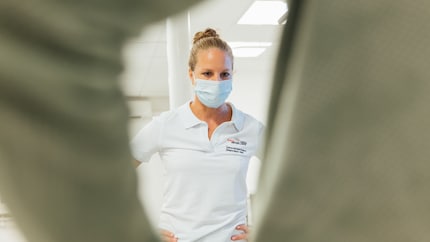
We put ourselves in a gymnastics room that we don't really need. "You can integrate most of the exercises of the Foot School very well into everyday life," says Pascale. "For example, while you're waiting for the coffee to be in the cup or while you're brushing your teeth." That makes more sense than staring at the wall or looking at your smartphone. Focus on your feet. Here we go.
"It's a good idea to first feel how you're standing while you're standing," Pascale begins. "Where do you have contact and where not? Is there a difference on the left and right? Are you standing more on your heel or is the weight more on your toes? How about in the midfoot area? More on the outside edge or are you dropping inward all over the place? How about the hollow of the arch of the foot?" Questions upon questions that I can now answer better thanks to my gait analysis.
Feeling something is one thing. Doing something is quite another. Sometimes even small movement tasks are surprisingly difficult. "First, you might have to feel again that you can move your toes independently of your back foot," Pascale says, pulling hers up. "Those are little things like that that make for better mapping on the motor cortex in the brain, which also leads to better control." I immediately notice that there's a need for optimization here - my toes react differently to commands on the left and right. Give it a try. I bet the following exercises will cause a few moments of surprise for you, too.
"You can try lifting only the big toe while standing," says Pascale. "And then, without pushing the others extremely down, move the big toe up and down alternating with the others." I notice that this is easier for me on the right than on the left. That's why you see my right foot here.
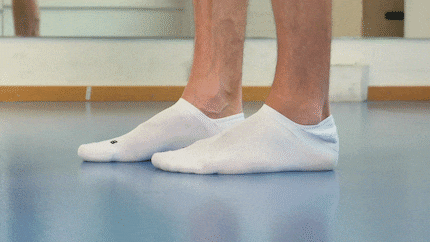
"Specific targeting is often side-dominant," Pascale explains, as I wonder about my unruly left foot. My consolation: I'm not alone with such problems. "Even just spreading the little toe is something many people can't do; everyone else comes right along with them." A little self-experiment confirms that, too, and I notice how I tense up. "If anything is uncomfortable, you should take a step back and maybe only try it with minimal pressure changes," is the advice in this case.
The goal is to make the foot more supple again, to also use the available muscles. "You're used to doing everything over the whole foot lift and not selectively moving the forefoot," Pascale says. I feel caught without being able to spontaneously change anything on the left foot. On the right, on the other hand, I manage the movement more loosely.
**Tips:**
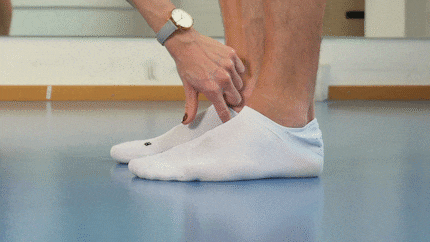
"We try to use the standing area from the ball of the foot to the heels and build the arch," Pascale explains of the little twitch in the foot, which is not so easy to implement. "It's about pulling the big toe base joint toward the heel. It's a very small movement where the toes should stay relaxed and keep contact with the ground." As inconspicuous as the movement is the insidious process that flattens our feet: "Many people need bigger shoes over the years because the arch collapses," says the physical therapist. So it pays not only to hang in the footbed, but to challenge the muscles.
**Tips:**
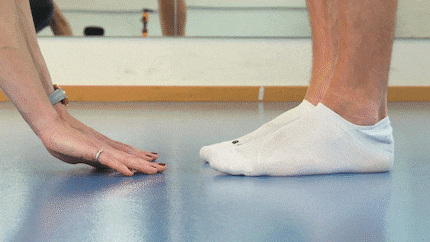
"Then you can move on to shifting the weight to the outside edges and feeling the change in tension," Pascale continues. "Maybe you'll notice something on the outside of the lower leg, or on the inside of the foot and the sole of the foot. There's a whole lot of little muscles that have to be involved that you wouldn't even realize you had otherwise." That works well. The countermovement toward the inside edge, on the other hand, isn't quite as easy.
"Dropping inward isn't as comfortable," Pascale says. "You usually do that via unraveling the arch of the foot." But rocking back and forth, shifting your weight from the inside out, you can do that. And the results of that are felt higher up after a while. "The movement is initiated in the foot, but it has effects all the way up to the hip. If you do it thirty times, it's going to be severe in the glutes as well."
**Tip:**
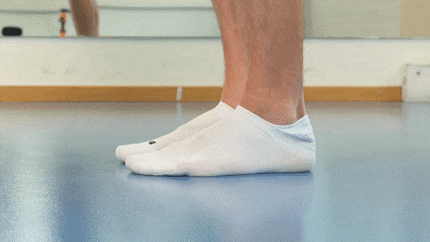
Here's where it gets wobbly. "Standing is followed by rolling, which is also challenging for balance," says Pascale. And a good opportunity to think about what exactly I'm doing. "When rolling over the foot, you can notice if you're rolling only over the outside edge, for example, and if the big toe or the little toes make contact with the ground first."
In a double-legged stance, rolling is relatively easy. But when walking or running, it often looks different: "There are people who walk extremely over the outside and have no contact at all on the big toe. That's a wasted resource, because the foot consists of the stability triangle of the heel, the underside of the outer edge and the metatarsophalangeal joint of the big toe. When we roll, we try to actually go over the base joint of the big toe at the end and perform the rolling motion completely that way." When standing, I have more trouble standing on my heels and lifting my toes: "Some people almost get a cramp in their shins." At least that doesn't happen to me.
**Tips:**
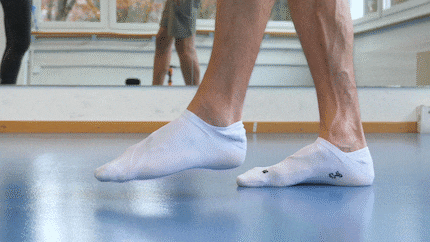
"Foot circles are also very simple and a challenge for your balance when standing," says Pascale. After all, the standing leg has to balance the movement I'm now focusing on. "To really do that in isolation, you need good neuromuscular control down there in the foot. Most of the time you can do it better one way than the other." Right. Interesting what a difference the direction of movement can make.
Tips:
Continue on one foot. "The one-leg stand is generally a good exercise for perception. You automatically adopt your preferred pattern and can try to dissolve that," says Pascale, while I try to find my balance and transfer it harmoniously to the foot. "That means putting weight on the ball of the foot, which is often lost otherwise, and especially not to claw with the toes. They should only be fine balancing parameters. They are there for fine tuning - not for spasmodically increasing the stance area. That's what the body wants in an unfamiliar situation, of course, for now."
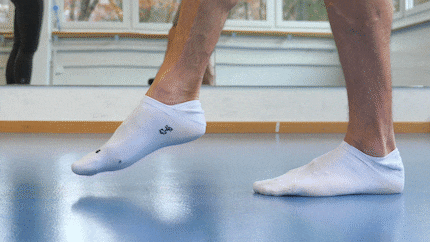
**Tips:**
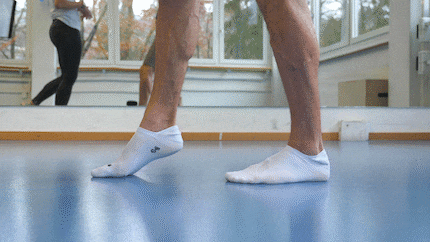
In the one-leg stand there are other variations with additional movements that the body has to compensate for. We tap the floor with the game leg in front and behind. "At the same time, you have to try to keep the arch of the foot upright, even if the game leg has another task at the moment," says Pascale. That's how it should be when running, too. "The idea behind it is to train the foot so that it knows what to do even in passive moments and, ideally, can maintain the arch even after a rigorous day."
**Tip:**
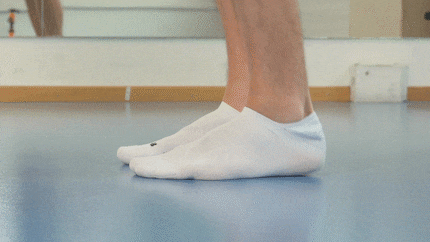
Since we're already treading water, after a while Pascale says, "Now we'd start running. If it's slow to build up to running, we'll start at the bottom of the ankle." For the triple steps called "Anklings," the process is similar to what you see above: "You just push off with more speed and take your arms with you," the expert explains as we move through the gym. "Even as we're doing that, we're trying to consciously use the forefoot and put weight on the metatarsophalangeal joint of the big toe. And we try to make it more dynamic. Then you don't just have the focus on the feet anymore and you have to be ready for that to work." Following that, he continues with "dribbles. "We start with the load on the forefoot, and the idea is that you spring from the ankle. The weight should never be on the heel."
Knee lifts ("skippings") are another element of running school that you probably know and can incorporate into your exercise routine. "Such exercises are also useful before jogging or walking, to train the interaction of the individual body sections and the fine motor skills in the foot." And in everyday life, it's worth incorporating occasional phases of movement. Small exercises while brushing teeth, under the desk, at the bus stop or in the evening in front of the TV. "It's neither realistic nor purposeful for this to happen throughout the day," says Pascale. Most of the time, we walk or stand without thinking about what's going on. "But you should keep thinking about it and encourage the perception that there aren't just two stilts down there."
Simple writer and dad of two who likes to be on the move, wading through everyday family life. Juggling several balls, I'll occasionally drop one. It could be a ball, or a remark. Or both.
Practical solutions for everyday problems with technology, household hacks and much more.
Show all